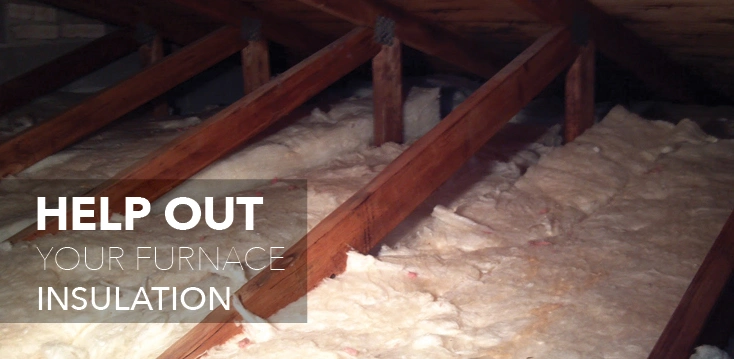Help Out Your Furnace: Insulation

Unless your home was built specifically for energy efficiency, you can probably reduce your heating bills this winter by adding insulation. While owners of older homes tend to benefit the most from adding insulation, even newer homes can experience an efficiency boost from this upgrade. Here’s what you need to know if you’re thinking of adding insulation to help your furnace run more efficiently this winter.
Why Insulation is Important
Step outside on a cold day without a jacket and time how long it takes for you to feel cold. Now put on a heavy, insulating coat and repeat the experiment. Adding insulation to your home’s walls, floors and ceilings helps keep the heat in the same way a coat helps you maintain your body heat.
Of course, a home with lower heat loss helps out your furnace. The equipment runs less often, which lower your bills and puts less strain on the heating equipment. It’s a win-win situation!
Choosing Insulation
Insulation comes in a variety of materials available in four main types, including:
- Rolls and batts: These flexible products are available in various dimensions designed to fit perfectly between joists and studs built to code. They’re often made of fiberglass.
- Rigid foam: While more expensive than rolls and batts, rigid foam offers twice the R-value per inch of thickness than most insulating products, making it ideal for sheathing basement walls and insulating attic hatches.
- Spray foam: Also known as foamed-in-place insulation, this is often applied to open wall cavities, finished walls and attic surfaces. Its free form makes it ideal for oddly shaped or obstructed areas.
- Loose-fill: Also called blown-in insulation, this is another option for areas where other types of insulation aren’t feasible due to strange dimensions. Cellulose and fiberglass are common loose-fill materials.
Determining Where to Add Insulation
The easiest way to evaluate your home’s insulation level is to have an energy audit performed. If you don’t want to hire an energy auditor, you can perform your own inspection. Check the following areas, determine how much insulation you already have and decide if you want to add more.
Attic
A thick layer of insulation should line the attic floor. Measure its depth with a ruler to determine if it achieves the recommended insulation level of R-30 or greater. This equates to 11 inches of fiberglass batts or 8 inches of loose-fill cellulose. Basically, if you can see the floor joists poking through the insulation, you could benefit from adding more.
Exterior Walls
Turn off power to an electrical outlet, remove the cover and peer inside with a flashlight. Check whether insulation is present and how thick it is. Repeat this with several outlets across different walls for a thorough assessment. If you find that the insulation is inadequate, consider adding loose-fill or spray foam insulation. If you’re doing a major remodel and opening the walls, batts and rolls are also options.
Unfinished Basement Ceilings and Walls
Measure insulation thickness in the basement. Keep in mind that if your home was built recently, it may feature insulation on the foundation wall exterior. If so, the insulation won’t be visible. Ask your builder for more information.
When adding basement insulation, make the interior walls the highest priority. While almost any type of insulation is appropriate for unfinished basement walls, rigid foam is an especially good choice.
Ductwork
Don’t forget this often overlooked area! Hire a professional to seal your ductwork and apply insulation on any ducts traveling through the attic, garage or crawlspace.
Interested in increasing insulation levels for lower heating bills? Contact Aire Serv® today to learn more.
 Click to call
Click to call


